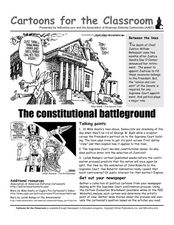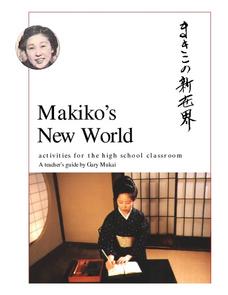Curated OER
Cartoons for the Classroom: The Bush-Clinton Years
In this current events instructional activity, students analyze a political cartoon about political dynasties and respond to 3 talking point questions.
Curated OER
Cartoons for the Classroom: Fat Cats Living off the High Hog
In this current events worksheet, students analyze a political cartoon that uses an idiom to convey its meaning. Students respond to 4 talking point questions.
Curated OER
Cartoons for the Classroom: Ebony and Ivory Revisited
In this current events worksheet, students analyze a political cartoon about the state of New Orleans after Hurrican Katrina and respond to 3 talking point questions
Curated OER
Cartoons for the Classroom: Unhealthy Outlook
In this current events instructional activity, students analyze a political cartoon about healthcare issues during the Clinton administration and respond to 3 talking point questions.
Curated OER
Cartoons for the Classroom: Gas Pains? Been There, Done That
In this current events learning exercise, students analyze political cartoons about gas prices and respond to 3 talking point questions.
Curated OER
Cartoons for the Classroom: The Constitutional Battleground
In this primary source analysis worksheet, students analyze political cartoons about the Supreme Court and Constitutional issues and respond to 5 talking point questions.
Curated OER
Cartoons for the Classroom: The Borgman Challenge
In this current events worksheet, students analyze political cartoons by Jim Borgman. Students respond to 3 talking point questions.
Curated OER
Makiko's New World
Students analyze the internal and external causes of the Meiji Restoration. They look at the goals and policies of the state and their impact on Japan's modernization. Students also assess the impact of Western ideas on Japan and realize...
Curated OER
Life Science: Heavy Weight
Students investigate adolescent obesity and its health impact. In this health and obesity lesson, students research the problem, develop a survey regarding eating habits, then analyze the nutritional information on commonly eaten foods...
Curated OER
Andrew Jackson and the Use of Martial Law and the Suspension of Habeas Corpus
Students explore the use of martial law at the Battle of New Orleans. In this Andrew Jackson lesson, students analyze primary documents pertaining to the move by Jackson to use martial law in the battle. Students then consider situations...
Curated OER
Cannabis and Young People
Students identify, analyze and characterize smoking and young people.
They try to consider why young people take drugs to begin with. In addition, they point out the effects and risks of cannabis smoking with young people. They also...
Curated OER
Heroism in Hispanic Countries
Students investigate foreign newspapers written in Spanish. They pick an article to be read and summarized in English. This lesson develops the skill of word recognition and sentence structure.
Curated OER
Write All About It
Fourth graders use research skills and the writing process to create a newspaper. Although students work in groups to complete the final draft of the newspaper, each student is responsible for doing his or her own research and writing...
Code.org
Check Your Assumptions
Always check your assumptions when interpreting data and data visualizations. That's the take away from this exercise. Class members examine a failed project that looks at search trends to predict flu outbreaks and consider the...
California Department of Education
What’s A Hot Job?
What jobs are the next best thing? Curious career scholars explore their options in activity three of a five-part series. Pupils research job trends and labor statistics before discussing the factors that influence occupation trends.
Curated OER
Meaning of Philanthropy
Students explore the concept of philanthropy. In this service learning lesson, students discover what philanthropy is and identify people who benefit from philanthropy. Students read selected newspaper articles regarding philanthropy and...
Curated OER
Can We Live in Peace? Middle East: A Region in Turmoil
Seventh graders analyze three monotheistic religions as an appreciation of the Middle East. For this world religions lesson, 7th graders analyze the beliefs and the leaders of the three major religions. Students research a topic and...
Curated OER
Stem Cells and Cloning
Students discuss an article on cloning and stem cells and complete an Internet cloning activity. For this genetic engineering lesson, students analyze stem cell issues by reading an article and participating in a class discussion. They...
Curated OER
Case studies in journalistic ethics No. 1
Students examine the importance and responsibilities of journalists through examination of illegal immigration. In this journalistic ethics instructional activity students analyze scenarios and look at the pros and cons of illegal...
Curated OER
About Life: The Photographs of Dorothea Lange
Students use art to analyze a period in history. For this lesson about the effect of art on history, students study many different pieces of photography by Dorothea Lange. Students will observe photographs from certain time periods and...
Curated OER
Night by Elie Weisel
Students read "No News from Auschwitz" and answer the study questions as an introduction to the novel. They record reactions to the essay and compare with reactions after reading "Night".
Curated OER
Is A Nation Always A Region?
Students define the term, "nation," and analyze the boundaries established in Africa by colonial powers. In small groups, they participate in a simulated United Nations, develop a list of questions, analyze the nations of Africa, and...
Curated OER
Creating War Propaganda
Learners analyze propaganda techniques using posters, speeches, and other examples of this type of persuasion. They use this information to design their own examples of propaganda. They focus on propaganda techniques used during war.
Curated OER
Calendar Clues Worksheet
In this birthday calendar worksheet, students look closely at a classroom birthday calendar and use the graphic organizer on the worksheet to analyze the data. Then students use the data to write a newspaper story, poem , or story.

























